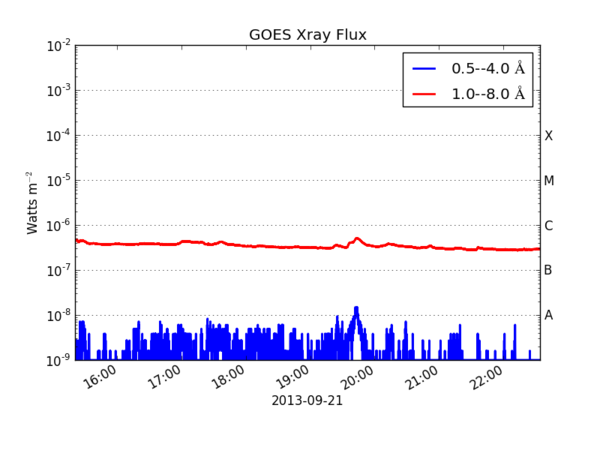The HEROES Mission: High Energy Replicated Optics to Explore the Sun
From RHESSI Wiki
| Nugget | |
|---|---|
| Number: | |
| 1st Author: | Steven Christe |
| 2nd Author: | Albert Shih |
| Published: | |
| Next Nugget: | TBD |
| Previous Nugget: | |
| List all | |
Contents |
Introduction
The High Energy Replicated Optics to Explore the Sun (HEROES) mission is a collaborative effort between the NASA Marshall Space Flight Center and the NASA Goddard Space Flight Center to upgrade an existing payload, the High Energy Replicated Optics (HERO) balloon-borne telescope, to make unique scientific measurements of the Sun and astrophysical targets during the same flight. On September 21, 2013, HEROES was launched successfully from Fort Sumner, NM at 05:55 am local time. HEROES remained at float altitudes for a total of 21 hours and spent a total of 7 consecutive hours observing the Sun. This nugget is a summary of the flight. A future nugget will discuss the science results from this flight.
HEROES was funded by the NASA HOPE (Hands On Project Experience) Training Opportunity awarded by the NASA Academy of Program/Project and Engineering Leadership, in partnership with NASA's Science Mission Directorate, Office of the Chief Engineer and Office of the Chief Technologist. HOPE is a one-year program to provide early-career NASA employees experience on a flight program from conception to actual flight. In practice, HOPE participants develop, build, and fly an instrument on a sub-orbital program while maintaining similar standards and reviews to a large scale flight mission.
Background
The HEROES science payload is a hard X-ray telescope. Similar to FOXSI_Success FOXSI which flew successfully one year ago in November of 2012, HEROES also uses high-resolution MSFC-developped hard x-ray grazing incidence optics. Unlike FOXSI, HEROES cannot observe below 20 keV due to the fact that high-altitude scientific balloons can only reach altitudes of about 40 km. At this height the atmosphere is still thick enough to block X-rays below that energy. On the other hand, a scientific balloon platform can accommodate much larger payloads so the HEROES optics have a 6 meter focal length as compared to FOXSI's 2 m. This means that HEROES can observe all the way up to 60 keV emission. The HEROES telescope consists of a total of 8 identical mirror modules and makes use of position-sensitive xenon gas scintillation proportional counters as the focal-plane detectors.
Science Goals
The solar science objectives for this flight were
- Investigate electron acceleration in the non-flaring solar corona by searching for the hard X-ray signature of energetic electrons.
- Investigate the acceleration and transport of energetic electrons in solar flares.
Since the Sun does eventually set, HEROES also had astrophysical science objectives as well
- Investigate the scale of high energy processes in a pulsar wind nebula.
- Investigate the hard X-ray properties of astrophysical targets such as X-ray binaries and active galactic nuclei.
Solar Aspect System
The original HERO payload has flown several times already, most recently in 2011 from Alice Springs, Australia to observe the Crab Nebula under the leadership of Dr. B. Ramsey. To point to astrophysical targets, the HEROES payload makes use of a sensitive star camera which identifies star fields in real-time with sub-arcminute accuracy. Unfortunately this aspect system cannot be used to point to the Sun because it would be blinded, possibly damaged, and confused by the bright and resolved Sun. We therefore developed a solar aspect system (SAS) to add to the HEROES payload to provide solar pointing ability and knowledge. The original conception of the SAS must credit the aspect system being developed for the The Gamma-Ray Imager/Polarimeter for Solar flares (GRIPS) another balloon payload. The HEROES SAS consists of the
Solar Observations
These flaring patterns suggest that clues to the nature of the dynamo could come from an assessment of its time/space structure as an eigenmode problem, based on patterns like these. Note that the organization of the coordinated eruptions crosses the equator in the case of the 2003 Halloween flares. This had been suggested in Ref. [1], but so far as we're aware there is no parallel work on the flare distributions. Patterns of coherence have also been remarked upon in terms of Svalgaard's "Hale sector" pattern; were the 2003 Halloween flares - though in both hemispheres - within the same sector?
Conclusions
We have pointed out another feature of the large-scale organization of the solar magnetic field, namely the intense energy it transports and delivers to solar flares. These have extremely short time scales, and yet they occur in structured patterns across space and time, something known since the sunspot cycle and butterfly diagram were first recognized (see also a Yohkoh Science Nugget on a related topic.
References
| RHESSI Nugget First Author | Steven Christe + |
| RHESSI Nugget Second Author | Albert Shih + |

